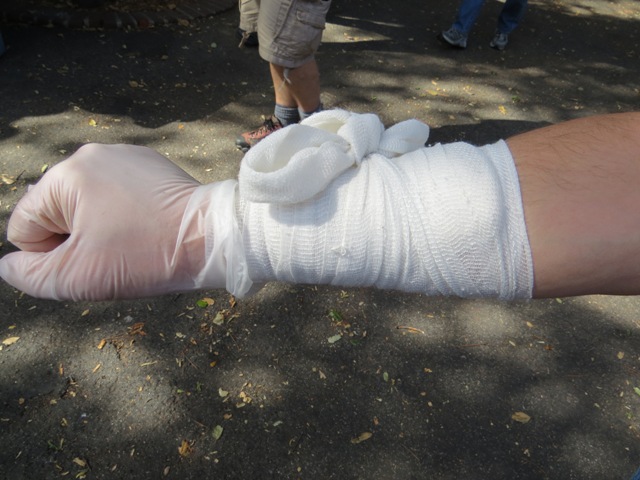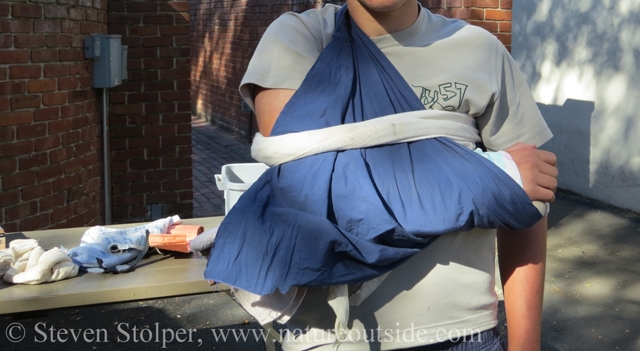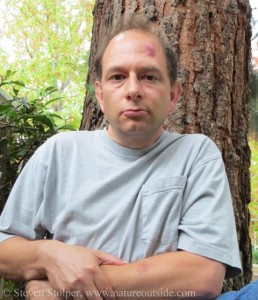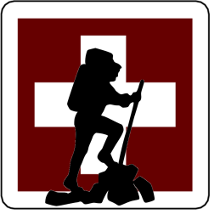
Before there was medicine, there was “wilderness medicine”…
– Buck Tilton, Wilderness First Responder: How to Recognize, Treat, and Prevent Emergencies in the Backcountry, Globe Pequot, 2004
This week I recertify my 16-hour wilderness first aid. I have been reading all week to prepare for the two-day course, which includes both classroom and practical training.
Duty of Care to Yourself
Bushcraft contains elements of self-reliance often missing from our modern existence. There’s an implicit understanding that if you venture into the wilderness, you should have the skills you need to look after yourself.
The ability to care for yourself if you become sick or injured should be one of the skills you cultivate. It’s part of your Duty of Care to Yourself when you journey into the wild. I first heard this term used by British bushcraft expert, Ray Mears, in one of his videos. The phrase intrigued me. Do we we have a responsibility to ourselves to be safe? I gave it some thought and here is where it led me. My personal definition:
- I have a duty of care to myself to possess the skills to journey safely in the wilderness.
- I have an obligation to return safely to those who love me, depend on me, and await my safe return.
This obligation increases exponentially if you lead others into the back country. You become the Ernest Shackleton, the Meriwether Lewis, the John Rae of your party. You are responsible for the safe return of your people. As leader, you assume an ethical “Duty to Act” even if there is no legal one. And the group may be as small as you and your child. What if your child is the one sick or injured?
Does it make sense to venture into the wilds without the knowledge of how to treat sickness and injury?
If your wilderness first aid training is “rub a little dirt on it” or “I once saw my friend Bob stitch himself up”, then perhaps your outdoor skills are not as complete as you think…
What You will Learn
In a 16-hour wilderness first aid course, the most important thing you learn is what to do in a medical emergency. Emergencies are frightening, and knowing what to do is essential for keeping calm and making rational decisions. Having a plan also helps if you are squeamish. It allows you to act instead of becoming overwhelmed by what is happening.
The course teaches two distinct types of skills: Judgment/strategy and technical procedures. Knowing how to immobilize the spine is a technical procedure. But the course teaches you to understand when to take this precaution. Both types of knowledge are vital if you want to help people who are sick or injured far from civilization.
Here is a list of some of the skills you learn:
- Assessing scene safety
- How to assess patient injuries or illness
- How to treat life-threatening injuries (airway/breathing, bleeding, shock)
- How to treat traumatic injuries (head, spine, burns, wounds, musculoskeletal injuries, chest injuries)
- Environmental Emergencies (hypothermia, frostbite, heat illnesses, lightning, altitude, animal bites)
- Treating medical emergencies (illness/infection, anaphylaxis, abdominal injuries)
- Leadership and Evacuation
- Legal considerations
- How to use first-aid supplies and equipment
If you take a wilderness first aid course you are investing in yourself – an investment that pays huge dividends if you ever have to use what you’ve learned.

Practicing a compression bandage

Improvised sling for a simulated broken arm
The Closest thing to a Real Accident

Ten minutes after the accident, you find a mountain biker sitting on the trail with his bike lying beside him. He has a head injury, a broken arm, and a broken collar bone (hidden by clothing). Is that all that’s going on? You are in Moab, Utah. You learn he ran out of water four hours ago…
Scenarios play an essential role in a wilderness first aid class. These realistic situations cover everything from trauma to diabetic hypoglycemia. Patients wear fake blood and makeup to simulate trauma. They “act the part” of the unresponsive diabetic with low blood sugar, the climber who falls 30 feet, or the frantic hiker stung by a bee.
You get to “run the playbook” in each case, learning how to filter and prioritize information under stress. You practice diagnostic skills that allow you to “look deeper” for the root cause of the problem. If you take the right actions, the patient’s condition improves. Miss something vital and your patient pays the price.
The experience of doing scenarios, watching your friends work scenarios, and acting as a patient increases your capacity to handle the real thing. You understand the priorities, dynamics, and stress before you ever see a real emergency. You experience first-hand how quickly a person gets chilled lying on the cold hard ground. All before you meet your first patient.
Who would you rather hike with:
A woodsman with the skill and experience to treat sick and injured people in the wilderness? Or, someone without a clue?
Start Today!
 It is never too late to begin learning wilderness medicine. Start by taking a basic CPR class from your local Red Cross. Then look for a reputable teacher to obtain either a 16-hour Wilderness First Aid certification, or the more comprehensive 80-hour Wilderness First Responder training.
It is never too late to begin learning wilderness medicine. Start by taking a basic CPR class from your local Red Cross. Then look for a reputable teacher to obtain either a 16-hour Wilderness First Aid certification, or the more comprehensive 80-hour Wilderness First Responder training.
Do it for yourself, for those who love you, and for those who rely on you for their safety in the wilderness.
Let me know about your level of medical training by leaving a comment below….
Further Reading
Here are two small manuals that fit easily into a first-aid kit (affiliate links).
Backcountry First Aid and Extended Care (Falcon Guide), Buck Tilton, Globe Pequot Press, 2007
Wilderness and Travel Medicine, Eric A. Weiss M.D., Mountaineers Books, 2012
More Wilderness First Aid on NatureOutside
Review: Maxpedition Individual First Aid Pouch
Tick Aware – Get a Free Tick Identification Card
My Most Popular First Aid Supply of the Year – 2016
For fun facts and useful tips, join the free Bushcraft Newsletter.



stephen. thanks for all the great info. your web site has become one of my go to sources. would you please point me in the direction to know what i should compile in an outdoor first aid kit. i know this is a general question with many possibilities. i am very interested in taking some classes from Foster Calm. thanks again and keep up the great work. hopefully this spring i can participate in some of your activities.
Thanks for the kind words, Art!
Once you attend a WFA class, you’ll be in a better position to decide what you think is important to include in your first aid kit. I have a personal first aid kit and a different (larger) one I use for overnight group trips. My personal first aid kit covers the following areas: Prescription Medication, blister care, OTC medication (pain relief, diarrhea, constipation, antihistamine), wound care (bandages, tape, wound cleaning) and CPR. It includes a first aid booklet and nitrile gloves. Everything else is based on your personal preference. For example, I carry items bite/sting and splinter care.
For a little more information about what I carry, check out this article: https://www.natureoutside.com/maxpedition-individual-first-aid-pouch/
REI and the Washington Trails Association publish kit-lists online (as well as others). This is a good place to start. But the key is knowing how to use what you have.